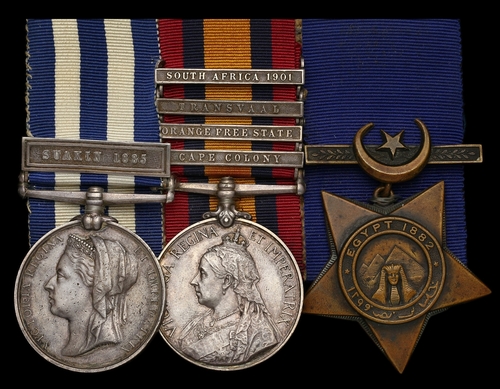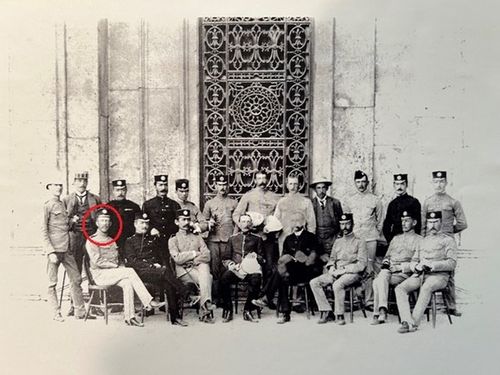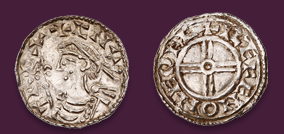Auction: 25002 - Orders, Decorations and Medals
Lot: 94
Three: Major J. H. W. Eyton, Shropshire Light Infantry, later Imperial Yeomanry, who was 'mentioned' for his command of the Shropshire Company of the Camel Corps at Suakin and later served in Hong Kong during the plague years
Egypt and Sudan 1882-89, dated reverse, 1 clasp, Suakin 1885 (Capt: J. H. W. Eyton. 1/Shrops:L.I.); Queen's South Africa 1899-1902, 4 clasps, Cape Colony, Orange Free State, Transvaal, South Africa 1901 (Major. J. H. W. Eyton. 9/Impl.Yeo.); Khedive's Star 1882, unnamed as issued, mounted court-style as worn, pitting and contact wear, overall very fine (3)
Provenance:
Spink Numismatic Circular, April 1975.
M.I.D. London Gazette 25 August 1885.
John Hope Wynne Eyton was born at Mold, Flintshire on 19 April 1852, the son of Thomas and Katharine Wynne Eyton. Commissioned 2nd Lieutenant on 1 February 1873 he was further advanced Lieutenant on 1 February the following year. Eyton served at home for much of his early career being again promoted, this time to the rank of Captain on 1 July 1881.
He was finally to see active service the following year when the Anglo-Egyptian War broke out and the Regiment was posted to Egypt. Eyton arrived there on 10 August 1882 and was to see action there as part of Hamley's Brigade assigned to defend Alexandria. This unit was stationed at the frontline near Kafr El Dawwar where they skirmished with Egyptian troops, distracting them from the movements of General Wolseley's army advancing on Tel-El-Kebir. They were finally also present for the surrender of Damietta. Eyton was posted to Malta the next year on 19 February 1883.
Posted to Suakin on 26 February 1885 as part of General Graham's Suakin Field Force the Shropshire Light Infantry were not present for the action at Tofrek. That is not to say however that they did not face action, especially Eyton who had been advanced Brevet Major at this point and was appointed to command the Shropshire Light Infantry Camel Company.
This unit was used to scout the area around Suakin and they faced their fair share of action during the months that Osman Digna was threatening the town. Suakin 1885 Being a Sketch of the Campaign of this Year by Major E. Gambier-Perry notes one action faced by the unit stating:
'… about one o'clock in the morning we suddenly heard a tremendous row going on just in our rear, and we thought at first that a party of the enemy had entered our horse-lines, but running out of the tent we found that the rearguard of the 53rd [Shropshire Regiment] were being attacked. It was always very difficult to make out from whence sounds came at night; the air was so clear that you could hear people shouting as if they were close to you, when in reality they were a mile or more off.
This attack on the rear-guard of the 53rd was a most audacious proceeding on the part of the enemy. The guard, fortunately for them, were lying own outside the guard-tent, while the double sentry patrolled up and down about fifteen yards in front, and behind a low-shelter trench. All at once a party of some fifteen to twenty Arabs, who had crawled towards them in the darkness, jumped up, rushed up to the parapet, fired a volley or two into the guard, and then disappeared again immediately. The guard who were under arms in a moment, fired in the direction of their retreat, but, so far as could be gathered, without effect. The casualties among them guard were three men wounded, while a fourth had his rifle knocked out of his hand by a bullet which passed straight through the stock….'
Leaving Suakin on 1 October Eyton returned home where the rank of Major was confirmed on 1 September the following year. Posted back to Egypt in December he was likely part of the British force which guarded the border against further Mahdist incursions. Further postings followed in Malta and back in Britian and Egypt before Eyton was sent to join the 1st Battalion in Hong Kong on 2 December 1891.
Whilst there he became a member of the Hong Kong Rifle Association, winning the Silver Spoons in 1894. That same year Hong Kong was wracked by a severe outbreak of plague, the government response made use of every available asset including the Shropshire Light Infantry. The role of the K.S.L.I. is outlined well by an article on the Soldiers of Shropshire Museum website which states:
'Those responsible for conducting house inspections, as well as disinfecting them, became known as the Whitewash Brigade - and this is where the KSLI came into action. Due to being stationed out in Hong Kong at the time of the outbreak, KSLI volunteers sprang into action to begin supressing the disease. Amongst other things, the KSLI were responsible for spraying/fumigating houses, whitewashing walls with lime and even clearing corpses out of houses. Those having their houses inspected would be given clean clothes and their own clothes would be sent to a disinfecting station. An article from the 1939 Hong Kong Press wrote that although the job of the KSLI was "gruesome", it was "not altogether unpopular with the soldiers. Military discipline of the Barrack Square had to disappear and with a generous rum ration, given with a view to warding off infection, they carried out their strange duties with the utmost cheerfulness".'
Eyton left Hong Kong on 21 December 1894 returning to India where he served until 29 July 1895. Joining the Reserve of Officers in 1898 he joined the Imperial Yeomanry in 1900 for service in South Africa, joining the 9th (Welsh) Company in the Orange Free State. There he saw action at Ladybrand and operations in Cape Colony; sold together with copied research.
Subject to 20% VAT on Buyer’s Premium. For more information please view Terms and Conditions for Buyers.
Sold for
£1,100
Starting price
£400







